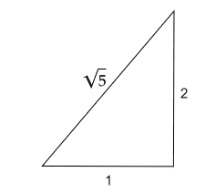
How do you find the exact value of $\arctan (2)$?
Answer
543.3k+ views
Hint: $\arctan (2)$ cannot be represented as a rational number of degrees or as a rational multiple of $\pi$radians. We need to represent $\arctan (2)$ as a sum of an infinite series. $\arctan (x) = \sum\limits_{k = 0}^\infty {{{( - 1)}^k}\dfrac{{{x^{2k + 1}}}}{{2k + 1}}}$.
Complete Step by Step Solution:
Consider the following right-angled triangle

These sides of the triangle for $\arctan (2)$ are as follows:
Opposite = 2, Adjacent = 1, and Hypotenuse = $\sqrt 5$
However, $\arctan (2)$ cannot be represented as a rational number of degrees or as a rational multiple of radians.
Therefore, we need a different method to represent this. Hence, we represent $\arctan (2)$ as a sum of an infinite series.
$\arctan (x)$can be represented as
$\Rightarrow \arctan (x)=\sum\limits_{k=0}^{\infty }{{{(-1)}^{k}}\dfrac{{{x}^{2k+1}}}{2k+1}=x-\dfrac{{{x}^{3}}}{3}+\dfrac{{{x}^{5}}}{5}-\dfrac{{{x}^{7}}}{7}+\dfrac{{{x}^{9}}}{9}-\dfrac{{{x}^{11}}}{11}+...}$
This, however, can only be converged for $|x| \leqslant 1$
In order for this series to converge, we need to use:
$\Rightarrow \tan \left( \dfrac{\pi }{2}-x \right)=\dfrac{1}{\tan x}$
Taking arctan on both sides of the equation, we get
$\Rightarrow \arctan \left( \dfrac{1}{x} \right)=\dfrac{\pi }{2}-\arctan \left( x \right)$
Substituting the values of x in the above equation,
$\Rightarrow \arctan (2)=\dfrac{\pi }{2}-\arctan \left( \dfrac{1}{2} \right)$
Simplifying the equation, we arrive at the conclusion,
$\Rightarrow \arctan (2)=\dfrac{\pi }{2}-\sum\limits_{k=0}^{\infty }{{{(-1)}^{k}}\dfrac{1}{{{2}^{2k+1}}(2k+1)}}$
Note:
Every trigonometric function has an inverse function. The inverse function works in a reverse manner. An inverse function is written with an arc in front of the name of the function, i.e., arcsine, arccos, arctan, etc. $\arctan (x)$ implies an angle whose tangent is equal to x.
$\tan \left( {60^\circ } \right) = 1.732$ which implies the tangent of $60^\circ$ is 1.732
$\arctan (1.732) = 60^\circ$ which implies the angle whose tangent is 1.732 is
Trigonometric functions can be applied to any angle including large and obtuse angles. However, inverse functions pose a problem because we will find many angles having the same tangent. For example, $45{}^\circ$ and $\left( 360+45 \right){}^\circ$ will have the same tangent. In order to solve this problem, the range of solutions of inverse functions is limited so that we get only one result for each input value.
Complete Step by Step Solution:
Consider the following right-angled triangle

These sides of the triangle for $\arctan (2)$ are as follows:
Opposite = 2, Adjacent = 1, and Hypotenuse = $\sqrt 5$
However, $\arctan (2)$ cannot be represented as a rational number of degrees or as a rational multiple of radians.
Therefore, we need a different method to represent this. Hence, we represent $\arctan (2)$ as a sum of an infinite series.
$\arctan (x)$can be represented as
$\Rightarrow \arctan (x)=\sum\limits_{k=0}^{\infty }{{{(-1)}^{k}}\dfrac{{{x}^{2k+1}}}{2k+1}=x-\dfrac{{{x}^{3}}}{3}+\dfrac{{{x}^{5}}}{5}-\dfrac{{{x}^{7}}}{7}+\dfrac{{{x}^{9}}}{9}-\dfrac{{{x}^{11}}}{11}+...}$
This, however, can only be converged for $|x| \leqslant 1$
In order for this series to converge, we need to use:
$\Rightarrow \tan \left( \dfrac{\pi }{2}-x \right)=\dfrac{1}{\tan x}$
Taking arctan on both sides of the equation, we get
$\Rightarrow \arctan \left( \dfrac{1}{x} \right)=\dfrac{\pi }{2}-\arctan \left( x \right)$
Substituting the values of x in the above equation,
$\Rightarrow \arctan (2)=\dfrac{\pi }{2}-\arctan \left( \dfrac{1}{2} \right)$
Simplifying the equation, we arrive at the conclusion,
$\Rightarrow \arctan (2)=\dfrac{\pi }{2}-\sum\limits_{k=0}^{\infty }{{{(-1)}^{k}}\dfrac{1}{{{2}^{2k+1}}(2k+1)}}$
Note:
Every trigonometric function has an inverse function. The inverse function works in a reverse manner. An inverse function is written with an arc in front of the name of the function, i.e., arcsine, arccos, arctan, etc. $\arctan (x)$ implies an angle whose tangent is equal to x.
$\tan \left( {60^\circ } \right) = 1.732$ which implies the tangent of $60^\circ$ is 1.732
$\arctan (1.732) = 60^\circ$ which implies the angle whose tangent is 1.732 is
Trigonometric functions can be applied to any angle including large and obtuse angles. However, inverse functions pose a problem because we will find many angles having the same tangent. For example, $45{}^\circ$ and $\left( 360+45 \right){}^\circ$ will have the same tangent. In order to solve this problem, the range of solutions of inverse functions is limited so that we get only one result for each input value.
Recently Updated Pages
Master Class 11 Economics: Engaging Questions & Answers for Success

Master Class 11 English: Engaging Questions & Answers for Success

Master Class 11 Social Science: Engaging Questions & Answers for Success

Master Class 11 Biology: Engaging Questions & Answers for Success

Class 11 Question and Answer - Your Ultimate Solutions Guide

Master Class 11 Business Studies: Engaging Questions & Answers for Success

Trending doubts
What is meant by exothermic and endothermic reactions class 11 chemistry CBSE

10 examples of friction in our daily life

One Metric ton is equal to kg A 10000 B 1000 C 100 class 11 physics CBSE

Difference Between Prokaryotic Cells and Eukaryotic Cells

What are Quantum numbers Explain the quantum number class 11 chemistry CBSE

1 Quintal is equal to a 110 kg b 10 kg c 100kg d 1000 class 11 physics CBSE




